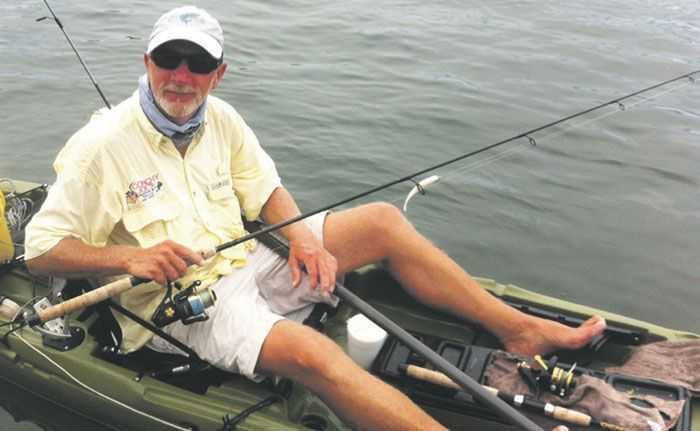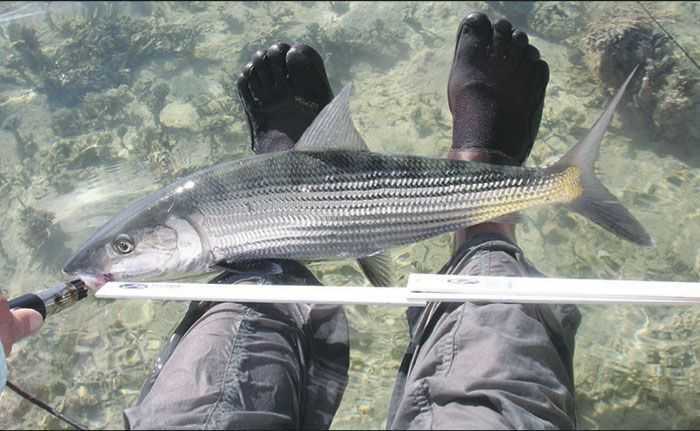by Randy Morrow
To the uninitiated, the speed of a bonefish’s first run is hard to believe. Line leaves the reel at an alarming rate, and many fishermen wonder if the fish might take it all and keep right on going. That first amazing run is, for most flats stalkers like myself, the true payoff of a lot of study and effort pursuing the gray ghost of the flats – the wily bonefish. And that first run is even more exciting from the cockpit of a kayak.
Many good books and articles have been written about bonefishing, and I’ve learned from all of them. But compared to the typical scenario of hunting bones from a flats skiff, stalking these wary, hard-to-see fish from a kayak presents unique challenges (and some advantages) which I’ll touch on in this and upcoming articles.
If you intend to have success with bonefish from a kayak, I believe you have to be able to paddle and pole the yak from a standing position. This necessitates a very stable kayak, and time spent practicing. Standing and silently moving the yak through shallow water needs to become second nature so you can concentrate your focus on looking for fish. Hunting bones from a seated position is next to impossible because you just can’t see them soon enough to make a presentation. You will occasionally find tailing fish, or fish making wakes in very shallow water, and these can be fished while seated. But 90 percent of the bones I catch are spotted while standing and poling the kayak.
Perched high on the bow of a skiff’s casting platform, you can see fish at quite a distance – often 100 feet or more. Add the assistance and trained eyes of a veteran guide on the poling platform, and generally you’ll have 6, 8, maybe even 10 seconds to track the incoming fish and make your presentation. If it’s off target, you may have time to make a second cast. But from the lower vantage point of a kayak, you typically won’t see bones until they’re within 60 feet of you – many times less than that. This cuts your lead time down drastically – to about 3 seconds on average – leaving very little room for error or second casts. And that brings us to the trickiest part of sight fishing from a kayak: the quick transition from poling to angling. My main method is as follows:
1) Have the rod with your lure or bait laying flat right in front of you and ready to cast. Have the bail in the right position, the preferred length of line past the tip top, and the drag set correctly. If using live shrimp, keep the shrimp in the water so its alive and frisky.
2) Once you’ve sighted the fish, bend your legs and lower yourself into a stable squatting position, lay the paddle across your lap, and pick up your rod. While you’re doing this, NEVER take your eyes off the fish. This paddle-to-rod transition has to be quick, silent, and done by feel – without looking. Practice it.
3) Make your cast from this squatting position.
4) Once you have a hook up, you can sit down in the kayak, leave the paddle balanced in your lap, and do battle to land the fish.
A secondary method I’ve found effective, given the right conditions, is drifting. If the current and/or wind isn’t too strong, simply stay standing and let the kayak drift, Park the paddle, have the rod in hand, bail open and ready to cast. You do give up some maneuverability of the kayak this way, but you cut the time necessary to cast to almost zero – a big advantage when operating in such close proximity to bonefish. This drifting method is very useful on a flat calm day when the fish are harder to approach, and longer casts become necessary. With the rod in hand, you can cast as soon as you see the fish and get a great shot before they’ve figured out you’re there. The biggest problem with drifting is going too fast and running over fish. If you’re using a bait bucket for shrimp, you can let it drag in the water to slow you down, much like a sea anchor. And as your skill increases, you can actually have the paddle in one hand for steering and braking, while you hold the rod with the other hand.
Bonefishing has been much better this year than last. So get your kayak out there and get busy with these silver speed demons!
Randy Morrow, Kayak Fishing Guide 305.923.4643 randrums@me.com Facebook – “Lower Keys Kayak Fishing” Member – Jackson Kayak Fishing Team
[easy-social-share]

